This is an old revision of this page, as edited by 213.142.27.109 (talk) at 09:50, 15 February 2011 (→Kingdom of Croatia: irrelevant information, probably a trolling attempt). The present address (URL) is a permanent link to this revision, which may differ significantly from the current revision.
Revision as of 09:50, 15 February 2011 by 213.142.27.109 (talk) (→Kingdom of Croatia: irrelevant information, probably a trolling attempt)(diff) ← Previous revision | Latest revision (diff) | Newer revision → (diff)| Republic of CroatiaRepublika Hrvatska | |
|---|---|
 Flag
Flag
 Coat of arms
Coat of arms
| |
| Anthem: Lijepa naša domovino Our beautiful homeland | |
 Location of Croatia (green) Location of Croatia (green) | |
| Capitaland largest city | Zagreb |
| Official languages | Croatian |
| Ethnic groups | 89.5% Croat, 4.5% Serb, 6% others |
| Demonym(s) | Croat, Croatian |
| Government | Parliamentary republic |
| • President | Ivo Josipović |
| • Prime Minister | Jadranka Kosor |
| • President of Parliament | Luka Bebić |
| Establishment | |
| • Principality | 785 |
| • Independent Principality | 879 |
| • Kingdom | 925 |
| • Union with Hungary | 1102 |
| • Joined Habsburg Empire | 1 January 1527 |
| • Independence from Austria–Hungary | 29 October 1918 |
| • Yugoslavia become Republic | 29 November 1943 |
| • Decision on independence | 25 June 1991 |
| • Declaration of independence | 8 October 1991 |
| Area | |
| • Total | 56,594 km (21,851 sq mi) (126th) |
| • Water (%) | 1.09 |
| Population | |
| • 2010 estimate | 4,486,881 |
| • 2001 census | 4,437,460 |
| • Density | 81/km (209.8/sq mi) (115th) |
| GDP (PPP) | 2010 estimate |
| • Total | $77.992 billion |
| • Per capita | $17,609 |
| GDP (nominal) | 2010 estimate |
| • Total | $59.917 billion |
| • Per capita | $13,528 |
| Gini (2008) | 29 Error: Invalid Gini value |
| HDI (2010) | 0.767 Error: Invalid HDI value (51st) |
| Currency | Kuna (HRK) |
| Time zone | UTC+1 (CET) |
| • Summer (DST) | UTC+2 (CEST) |
| Drives on | Right |
| Calling code | 385 |
| ISO 3166 code | HR |
| Internet TLD | .hr |
| |
Croatia (/kroʊˈeɪʃə/ kroh-AY-shə; Template:Lang-hr Template:IPA-sh), officially the Republic of Croatia (Croatian: Republika Hrvatska listen), is a country in Central Europe and Southeastern Europe at the crossroads of the Pannonian Plain, the Balkans, and the Adriatic Sea. Its capital and largest city is Zagreb. Croatia borders Slovenia to the north, Hungary to the northeast, Bosnia and Herzegovina to the southeast, Serbia to the east, and Montenegro to the southeast.
The Croats arrived in the early 7th century in what today is Croatia. They organized the state into two dukedoms. The first king, King Tomislav was crowned in AD 925 and Croatia was elevated into the status of a kingdom. The Kingdom of Croatia retained its sovereignty for almost two centuries, reaching its peak during the rule of Kings Peter Krešimir IV and Demetrius Zvonimir. Croatia entered a union with Hungary in 1102. In 1527, the Croatian Parliament elected Ferdinand from the House of Habsburg to the Croatian throne. In 1918, Croatia was included in the short-lived State of Slovenes, Croats, and Serbs that declared independence from Austria–Hungary and co-founded the Kingdom of Yugoslavia. An independent Croatian state briefly existed during World War II. After World War II, Croatia became a founding member of the Second Yugoslavia.
On 25 June 1991, Croatia declared independence and became a sovereign state.
Croatia is a member of the United Nations, the Council of Europe, NATO, the World Trade Organization and CEFTA. The country is a candidate for European Union membership and is a founding member of the Union for the Mediterranean. Croatia is classified as an emerging and developing economy by the International Monetary Fund and a high income economy by the World Bank.
History
Main article: History of CroatiaCroatia before Croats
Main article: Prehistoric Croatia See also: Dalmatia (Roman province), Pannonia Superior, Pannonia Inferior, and Illyria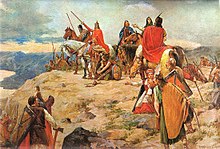
The area known as Croatia today was inhabited throughout the prehistoric period. Fossils of Neanderthals dating to the middle Paleolithic have been unearthed in the area of Krapina and Vindija. More recent (late Mousterian) Neanderthal remains have been discovered in Mujina pećina near the coast.
In the early Neolithic period, the Starčevo, Vučedol and Hvar cultures were scattered around the region. The Iron Age left traces of the Hallstatt culture (early Illyrians) and the La Tène culture (Celts).
Much later the region was settled by Liburnians and Illyrians, and Greek colonies were established on the islands of Vis (by Dionysius I of Syracuse) and Hvar. In 9 AD the territory of today's Croatia became part of the Roman Empire. Emperor Diocletian built a massive palace in Split where he retired from politics in AD 305. During the 5th century the last Roman Emperor Julius Nepos ruled his small empire from Diocletian's Palace before he was killed in AD 480.
The early history of Croatia ends with the Avar invasion in the first half of the 7th century and the destruction of almost all Roman towns. Roman survivors retreated to strategically better defended points on the coast, islands and mountains. The modern city of Dubrovnik was founded by those survivors.
Ethnogenesis of Croatian people (called White Croats before the migration) started with their emigration from the territory of White Croatia, located in central Europe, to the area of the present day Croatia and Bosnia and Herzegovina.
Kingdom of Croatia
Main article: Kingdom of Croatia (medieval)
The Croats arrived in what is today Croatia probably in the early 7th century. They organized into two dukedoms; the duchy of Pannonia in the north and the duchy of Littoral Croatia in the south. Emperor Constantine Porphyrogenitus wrote that Porga, Duke of the Dalmatian Croats, who had been invited into Dalmatia by Byzantine Emperor Heraclius, sent to Heraclius for Christian teachers.
According to Constantine, at the request of Heraclius, Pope John IV (640–642) sent Christian teachers and missionaries to the Croatian Provinces. These missionaries converted Porga, and also a great many of the clan that was under his immediate authority, to the Christian faith in 640. The Christianization of the Croats was mostly complete by the 9th century. Both duchies became Frankish vassals in late 8th century, and eventually became independent in the following century.

The first native Croatian ruler recognized by the Pope was duke Branimir, whom Pope John VIII called dux Croatorum ("duke of Croats") in 879. Duke Tomislav of Littoral Croatia was one of the most prominent members of the House of Trpimirović. He united the Croats of Dalmatia and Pannonia into a single Kingdom in 925. Traditionally it is stated that Tomislav's state extended from the Adriatic Sea to the Drava river, and from the Raša river to the Drina river, but the precise borders are unknown. Under his rule, Croatia became one of the most powerful kingdoms in Medieval Europe.
Tomislav defeated the invasions of the Árpáds in battle and forced them across the Drava. He also annexed a part of Pannonia. This included the area between the rivers Drava, Sava and Kupa, so his Duchy bordered with Bulgaria for a period of time. This was the first time that the two Croatian Realms were united, and all Croats were in one state. The union was later recognised by Byzantium, which gave the royal crown to Stjepan Držislav and papal crown to king Zvonimir. The medieval Croatian kingdom reached its peak during the reign of Kings Petar Krešimir IV (1058–1074) and Zvonimir (1075–1089).
The Kingdom of Croatia existed from its foundation in 925 until the end of World War I, initially as an independent kingdom and later as a crown in multiethnic empires such as the High Kingdom of Hungary, the Habsburg monarchy and Austria-Hungary.
Personal Union With Hungary
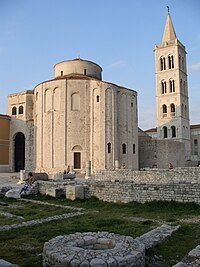
Following the extinction of the Croatian ruling dynasty in 1091, Ladislaus I of Hungary, the brother of Jelena Lijepa, the last Croatian queen, became the king of Croatia. Croatian nobility of the Littoral opposed this crowning, which led to 10 years of war and the recognition of the Hungarian ruler Coloman as the king of Croatia and Hungary in the treaty of 1102 (often referred to as the Pacta conventa). In return, Coloman promised to maintain Croatia as a separate kingdom, not to settle Croatia with Hungarians, to guarantee Croatia's self-governance under a Ban, and to respect all the rights, laws and privileges of the Croatian Kingdom. During this union, the Kingdom of Croatia never lost the right to elect its own king, had the ruling dynasty become extinct. In 1293 and 1403 Croatia chose its own king, but in both cases the Kingdom of Hungary declared war and the union was reestablished.
For the next four centuries, the Kingdom of Croatia was ruled by the Sabor and Bans appointed by the Hungarian king. The Kingdom of Croatia and Slavonia remained a legally distinct constitutional entity, but the advent of a Hungarian king brought about other consequences such as: the introduction of feudalism and the rise of native noble families such as the Frankopans and the Šubićs. The 1273 Congregatio Regni tocius Sclavonie Generalis, the oldest surviving document written by the Croatian parliament, dates from this period.
Subsequent kings sought to restore some of their previously lost influence by granting certain privileges to towns. The first period of personal union between Croatia and Hungary ended in 1526 with the Battle of Mohács and the defeat of Hungarian forces by the Ottomans. After the death of King Louis II, Croatian nobles at the Cetingrad assembly chose the Habsburgs as new rulers of the Kingdom of Croatia, under the condition that they provide the troops and finances required to protect Croatia against the Ottoman Empire.
Republic of Poljica
Main article: Republic of Poljica| This section is empty. You can help by adding to it. (September 2010) |
Republic of Ragusa
Main articles: Dubrovnik and Republic of Ragusa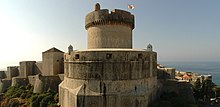
The city of Dubrovnik/Ragusa was founded in 7th century after Avar and Slavic raiders destroyed the Roman city of Epidaurum. The surviving Roman population escaped to a small island near the coast where they founded a new settlement. During the Fourth Crusade the city fell under control of the Republic of Venice until the 1358 Zadar treaty when Venice, defeated by the Hungarian kingdom, lost control of Dalmatia and the Republic of Ragusa became a tributary of that kingdom.
Through the next 450 years the Republic of Ragusa would be a tributary Republic protected by Ottomans and Habsburgs until Napoleon abolished it in 1808 when Ragusa, Croatia, Slovenia and Bosnia was briefly the Illyrian Provinces. During this time the republic became rich through trade.
The republic became the most important publisher of Croatian literature during the Renaissance and Baroque periods. Aside from poets and writers like Marin Držić and Ivan Gundulić, whose works were important for Croat literature development, the most famous person from the Republic of Dubrovnik was the scientist Ruđer Josip Bošković, who was a member of the Royal Society and the Russian Academy of Sciences. The republic would survive until 1808 when it was annexed by Napoleon. Today the city of Dubrovnik features on the UNESCO World Heritage Site list and is a famous tourist destination.
Ottoman Wars
See also: Croatian–Ottoman Wars and Ottoman wars in Europe
Shortly after the Battle of Mohács, the Habsburgs unsuccessfully sought to stabilise the borders between the Ottoman Empire and the Kingdom of Croatia by creating a captaincy in Bihać. However, in 1529, the Ottoman army swept through the area and captured Buda and besieged Vienna; an event which brought violence and turmoil to the Croatian border areas (see Ottoman wars in Europe). After the failure of the first military operations, the Kingdom of Croatia was split into civilian and military units in 1553. The latter became Croatian Krajina and Slavonian Krajina and both eventually became parts of the Croatian Military Frontier which was directly under the control of Vienna.
Ottoman raids on Croatian territory continued until the Battle of Sisak in 1593, after which the borders stabilised for some time. The kingdom of that time became known as the Reliquiae reliquiarum olim inclyti Regni Croatiae ("The remains of the once famous Kingdom of Croatia"). An important battle during this time was the Battle of Szigetvár (1566), when 2,300 soldiers under the leadership of ban Nikola Šubić Zrinski held back for two months 100,000 Ottoman soldiers led by Sultan Suleiman the Magnificent, fighting to the last man. Cardinal Richelieu was reported to have called the event "the battle that saved civilization."
During the Great Turkish War (1667–1698), Slavonia was regained but hilly western Bosnia, which had been a part of Croatia until the Ottoman conquest, remained outside Croatian control and the current border, which resembles a crescent or a horseshoe, is a remnant of this historical outcome. The southern part of the 'horseshoe' was created by the Venetian conquest following the Siege of Zara and was defined by the 17–18th century wars with the Ottomans. The de jure reason for Venetian expansion was the decision of the king of Croatia, Ladislas of Naples, to sell his rights on Dalmatia to Venice in 1409.
During more than two centuries of Ottoman wars, Croatia underwent great demographic changes. The Croats left the riverland areas of Gacka, Lika and Krbava, Moslavina in Slavonia, and an area in present day north-western Bosnia to move towards Austria where they remained and the present day Burgenland Croats are direct descendants of these settlers. To replace the fleeing Croats, the Habsburgs called on the Orthodox populations of Bosnia and Serbia to provide military service in Croatian and Slavonian Krajina. Serbian migration into this region, which had started in the 16th century, peaked during the Great Serb Migrations of 1690 and 1737–39. The rights and obligations of new populace of the Military frontier were decided with the Statuta Valachorum in 1630.
Austria–Hungary
Main articles: Kingdom of Croatia (Habsburg), Kingdom of Dalmatia, Kingdom of Slavonia, and Kingdom of Croatia-Slavonia See also: Austria-Hungary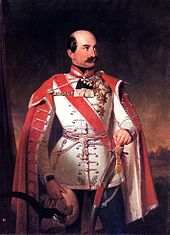
On January 1, 1527, Croatian noblemen gathered in the Cetin fortress in the city of Cetingrad for the Parliament on Cetin and elected Ferdinand, Archduke of Austria as the new king of the Croatian kingdom. Croatia of that time was named a triune kingdom: the Kingdom of Croatia, the Kingdom of Dalmatia, and the Kingdom of Slavonia. The kingdoms of Croatia and Slavonia united in 1868, creating the Kingdom of Croatia-Slavonia.
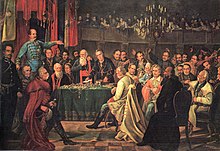
The Croatian answer to the Hungarian revolution of 1848 was a declaration of war. Austrian, Croatian and Russian forces together defeated the Hungarian army in 1849 and the following 17 years were remembered in Croatia and Hungary for the policy of Germanization. The eventual failure of this policy resulted in the Austro-Hungarian Compromise of 1867 and the creation of a monarchic union between the crowns of the Austrian Empire and the Kingdom of Hungary. The treaty left unanswered the question of the status of Croatia. The following year the Croatian and Hungarian parliaments created a constitution for union of the Kingdom of Croatia-Slavonia and the Kingdom of Hungary.
After the Ottoman Empire lost military control over Bosnia and Herzegovina, Austria-Hungary abolished Croatian Krajina and Slavonian Krajina, restoring the territories to Croatia in 1881. During the second half of the 19th century pro-Hungarian and pro-Austrian political parties played Croats against Serbs with the aim of controlling the parliament. This policy failed in 1906 when a Croat-Serb coalition won the elections. The newly created political situation remained unchanged until the advent of World War I.
National Revival
Main article: Illyrian movement
National revival in Croatia started in 1813 when the bishop of Zagreb Maksimilijan Vrhovac issued a plea for the collection of "national treasures". At the beginning of the 1830s, a group of young Croatian writers gathered in Zagreb and established the Illyrian movement for national renewal and unity of all South Slavs within the Habsburg Monarchy. The most important focus of the Illyrians was the establishment of a standard language as a counter-weight to Hungarian, and the promotion of Croatian literature and official culture.
Important members of this movement were Count Janko Drašković, who initiated the movement by writing a pamphlet in 1832, Ljudevit Gaj who received permission from the royal government of Habsburg for printing the first newspaper in the Croatian language, Antun Mihanović, who wrote the lyrics for the Croatian national anthem, Vatroslav Lisinski, composer of the first Croatian language opera, "Ljubav i zloba" ("Love and Malice", 1846), and many others.
Fearful first of Hungarian and then Habsburg (Austrian) pressure of assimilation, the Kingdom of Croatia had always refused to change the status of Latin as its official language until the middle of the 19th century. Only on 2 May 1843 the Croatian language was first spoken in parliament, finally gaining official status in 1847 due to the popularity of the Illyrian movement.
Even with a large Slavic (Croatian) majority, Dalmatia retained large Italian communities in the coast (in the cities and the islands, largest concentration in Istria). According to the 1816 Austro-Hungarian census, 22% of the Dalmatian population was Italian-speaking. Starting in the 19th century, most Dalmatian Italians and Morlachs with an Istro-Romanian language gradually assimilated to the prevailing Croatian culture and language.
Kingdom of Yugoslavia

After the defeat of the Central Powers in World War I, issues of Yugoslav unity became a major international issue.
On 29 October 1918, the Croatian Sabor (parliament) declared independence, creating the new State of Slovenes, Croats and Serbs. Pressured by the Italian army, which was entering its territory from south and west, the National Council (Narodno vijeće) started expedient negotiations with the Kingdom of Serbia and on November 23, 1918, a delegation was sent to Belgrade with the aim of a proclamation of union. The National Council delegation delivered 11 points which needed to be fulfilled for the creation of a future state.
The most important of these points was the first, which referred to the need of a constitution for the new state, a proposal that was passed with a two thirds majority. Eventually, a constitution for a centralized state was passed with a majority of 50% + 1 vote and caused the end of state autonomy. On 1 December 1918, the new Kingdom of Serbs, Croats, and Slovenes, colloquially known as Kingdom of Yugoslavia, was created. This decision created public outcry among Croats, which started a political upheaval for the restoration of state autonomy by the leadership of the Croatian Peasant Party.
Dalmatian Croat politician Ante Trumbić, a prominent Yugoslavist leader and head of the Yugoslav Committee during the war had vouched for the creation of a united Yugoslavia and represented Yugoslavia at the Paris Peace Conference of 1919. Trumbić successfully vouched for the inclusion of most Yugoslavs of the former Austria-Hungary to be included within the borders of Yugoslavia but failed to secure the inclusion of 500,000 Slovenes and Croats who were placed under Italian rule with the Treaty of Rapallo of 1920.
The formation of the constitution of 1921 sparked tensions between the different Yugoslav nationalities. Trumbić opposed the 1921 constitution and over time grew increasingly hostile towards the Yugoslav government that he saw as being centralized in the favour of Serb hegemony over Yugoslavia.
The unhealthy political situation in Yugoslavia became much worse after Stjepan Radić, the president of CPP, was killed in the Yugoslav parliament building in 1928 by Montenegrin Serb ultranationalist Puniša Račić.
The ensuing chaotic period ended the next year when King Alexander abolished the Constitution, prorogued the Parliament and introduced a personal dictatorship. The next four years of the Yugoslav regime were described by Albert Einstein in 1931 as a "horrible brutality which is being practised upon the Croatian People". During the dictatorship, Vladko Maček, leader of the Croatian Peasant Party, was imprisoned, only becoming free after king Alexander was killed in a plot organized by the Internal Macedonian Revolutionary Organization and Ustaše.
Upon Maček's release, the political situation was restored to that before the murder of Stjepan Radić, continuing Croatian demands for autonomy. The Croatian question was solved only on August 26, 1939 by the Cvetković-Maček Agreement, when Croatia received autonomy and an extension of its borders and Maček became Yugoslav vice-prime minister. The ensuing peace was terminated by the German invasion of 1941.
World War II
Main article: Yugoslav Front (World War II)The German and Italian invasion of April 6 1941 achieved victory over the Royal Yugoslav Army in little more than ten days, ending with the unconditional surrender of the Royal Yugoslav Army on April 17. The territory of Croatia, Bosnia and Herzegovina and the region of Syrmia became a puppet state of Nazi Germany called the Independent State of Croatia. Istria, the port city of Rijeka, and a portion of Dalmatia up to Split were occupied by Italy. Baranja and Medjimurje were occupied by Hungary. Although the recently returned exiled Ustashe was in charge of the new regime, the Axis occupiers initially offered the state leadership to Vladko Maček, the leader of the Croatian Peasants' Party (HSS), but he refused.
Only one day after entering Zagreb, on April 17, 1941, Ante Pavelić proclaimed that all people who offended, or tried to offend against the Croatian nation were guilty of treason — a crime punishable by death. The Ustashe regime introduced anti-Semitic Nuremberg-style laws, and also conducted massacres of mostly Serbs and other non-Croats, as well as running concentration camps such as the one at Jasenovac and Stara Gradiska where opponents of the Ustashe regime and other 'undesirables' were held. The Ustase murdered Serbs, Jews, Roma, as well as Croats who opposed Ustase rule.
Pavelić's Ustase regime was highly unpopular in Croatia at the time and lacked popular support due to Pavelić's secession of the largely Croat-populated region of Dalmatia to Fascist Italy and secession of territory to Hungary. In contrast Croatian politician Vlatko Macek held widespread support of a strong majority of Croatians. During this time, 200,000 Croats were sent as labourers to Nazi Germany while Germany exploited the state's natural resources.
Catholic priests who were involved in the Ustashe movement, particularly the notorious Father Miroslav Filipović were defrocked. However, others such as the Archbishop of Zagreb Alojzije Stepinac not only condemned Ustashe crimes in his sermons but also offered refuge and protection to persecuted Serbs and Jews. The Jewish Virtual Library estimates that between 45,000 and 52,000 Croatian Serbs were killed at Jasenovac and that between 330,000 and 390,000 Serbs were victims of the entire genocide campaign.
The remnants of the Royal Yugoslav Army, later reorganized into the predominantly Serbian Chetniks, offered resistance to the Nazi occupation and their Ustashe collaborators, but the Yugoslav Royalist Chetniks soon started collaborating with Nazis and Fascist Italy. Civil war broke out. Later, in response to Hitler's surprise "Operation Barbarossa" attack on the Soviet Union, a massive uprising began on June 22, 1941 with the creation of 1st Sisak Partisan Detachment.
The leadership of the Yugoslav partisan movement was in the hands of Croat Josip Broz Tito, whose policy of brotherhood and unity would in the end defeat not only the Axis occupiers, but also their various collaborators in the armed forces of the Independent State of Croatia and other quislings (which could be found in every Yugoslav social and national group). The victory of Tito's partisans against the Nazi occupiers and their allies resulted in the massacres of those Croatian Domobran (Home Guard) and Ustashe who were repatriated from Austria by the British 8th Army. During the war and in the decade after World War II, numerous Italian civilians were massacred by Tito's partisans, while up to 350,000 ethnic Italians were obliged to leave Yugoslavia.
The number of World War II victims in Yugoslavia remains a source of much controversy amongst Serb and Croat nationalist academics and historians on the one side, and independent researchers, mostly notably Vladimir Žerjavić (a Croat) and Bogoljub Kočović (a Serb), on the other.
Socialist Yugoslavia
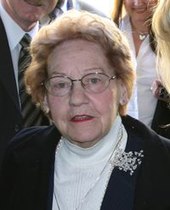
Modern Croatia was founded on AVNOJ anti-fascist partisans' principles during World War II, and it became a constitutional federal republic of the Socialist Federal Republic of Yugoslavia. A single-party socialist state was established but, because of the Tito-Stalin split, economic and personal freedom were better than in the Eastern Bloc. From the 1950s, the Socialist Republic of Croatia enjoyed an autonomy under the rule of the local Communist elite, but in 1967 a group of influential Croatian poets and linguists published a Declaration on the Status and Name of the Croatian Standard Language.
After 1968 the patriotic goals of that document morphed into a generic Croatian movement for more rights for Croatia, greater civil rights and demands for the decentralization of the economy. In the end the Yugoslav leadership interpreted the Croatian Spring as a restoration of Croatian nationalism, dismissed the movement as chauvinistic and arrested most of its important leaders. In 1974, a new Yugoslav federal constitution was ratified that gave more autonomy to the individual republics, thereby basically fulfilling the main goals of the Croatian Spring.
Independent Croatia
Main article: Croatian War of Independence
Nationalistic sentiment, which would bring an end to the Yugoslav federation, had been widespread among various ethnicities for some years. Albanian demands in 1981 for Kosovo to be removed from Serbia and transformed to a constituent republic within Yugoslavia led to riots, and similar attitudes surfaced among other nations with the Serbian SANU Memorandum in 1986; Croatia and Slovenia also responded negatively in 1989 after Serbia's leader Slobodan Milošević organized coups in Vojvodina, Kosovo and Montenegro to install authorities who would be loyal to his cause.
Croatia declared independence from socialist Yugoslavia in 1991. War broke out in 1991 with Yugoslav National Army open attacks on Croatia. At the end of 1991 there was full-scale war in Croatia. The war was between the Serbs, in what had been the Republic of Serbia in the former Yugoslavia, and Croats in the newly independent Croatia. The reasons for the war are very complex. Very simply, while Croatia and Slovenia wanted to separate from Yugoslavia, Serbs were largely unwilling to allow this to happen, probably largely for economic reasons.

Under the influence of Slobodan Milošević's propaganda, the importance of who won the first Croatian multi-party elections in 50 years was diminished. Allegedly, Serbs had influenced both Croatian nationalist leader Franjo Tuđman and communist leader Ivica Račan. The electoral win of Franjo Tuđman further inflamed the situation. Croatian Serbs left the Croatian parliament and created the Association of the Municipalities of Northern Dalmatia and Lika in Knin. This was later to become the Republika Srpska Krajina. On the events of 1990–92, Milan Babić, Serbian leader and president of Republika Srpska Krajina, was later to declare that he had been "strongly influenced and misled by Serbian propaganda".
These events culminated in the full scale Croatian War of Independence between 1991 and 1995. The war ended with Croatian victory with Operation Storm (known in Croatian as Oluja) in the summer of 1995. The events of August 1995 remain the subject of several cases before the International Criminal Tribunal for the former Yugoslavia, regarding the conduct of the victorious Croatian Army and the exodus of ethnic Serbs.
Croatia was internationally recognized on 15 January 1992 by the European Union, and subsequently the United Nations. During that time, Croatia controlled less than two thirds of its legal territory. The first country to recognize Croatia was Iceland on 19 December 1991.
Geography
Main article: Geography of Croatia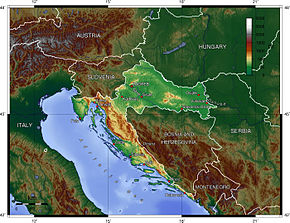
Croatia is located in South-eastern Europe between Bosnia and Herzegovina and Slovenia, and bordering the Adriatic Sea. It lies between latitudes 42° and 47° N, and longitudes 13° and 20° E.
Its shape resembles that of a crescent or a horseshoe, which flanks its neighbours Serbia, Bosnia and Herzegovina, and Montenegro. To the north lie Slovenia and Hungary; Italy lies across the Adriatic Sea. Its mainland territory is split in two non-contiguous parts by the short coastline of Bosnia and Herzegovina around Neum.
Its terrain is diverse, including:
- plains, lakes and rolling hills in the continental north and north-east (Central Croatia and Slavonia, part of the Pannonian Basin);
- densely wooded mountains in Lika and Gorski Kotar, part of the Dinaric Alps;
- rocky coastlines on the Adriatic Sea (Istria, Northern Sea coast and Dalmatia).




Phytogeographically, Croatia belongs to the Boreal Kingdom and is shared between the Central European and Illyrian provinces of the Circumboreal Region and the Adriatic province of the Mediterranean Region. According to the WWF, the territory of Croatia can be subdivided into three ecoregions: the Pannonian mixed forests, Dinaric Mountains mixed forests and Illyrian deciduous forests.
The country is famous for its many national parks. Besides national parks, Croatian laws provide special protection to ten more nature parks and two strict natural reserves. Around ten percent of total territory of Croatia is enjoying special protection by law in the aforementioned forms. Croatia has a mixture of climates. In the north and east it is continental, Mediterranean along the coast and a semi-highland and highland climate in the south-central region. Istra has a temperate climate, while the Palagruža archipelago is home to a subtropical climate.
Insular Croatia consists of over one thousand islands varying in size. The largest islands in Croatia are Cres and Krk which are located in the Adriatic Sea. The Danube, Europe's second longest river, runs through the city of Vukovar. Dinara, the eponym of the Dinaric Alps, is the highest peak of Croatia at 1,831 metres (6,007 feet) above sea level.
Karst topography makes up more than 50% of Croatia and is especially obvious in the area south of Karlovac. There are 49 caves deeper than 250 m (820.21 ft) in Croatia, 14 of them are deeper than 500 m (1,640.42 ft) and three deeper than 1,000 m (3,280.84 ft) (the Lukina jama-Trojama, Slovacka jama and Velebita cave systems). The deepest Croatian pits are mostly found in two regions – Mt. Velebit and Mt. Biokovo.
Important characteristic of Croatian landscape are numerous natural lakes. The biggest one, Vransko lake stretches over 30 km² in Zadar and Šibenik-Knin county. Interesting phenomena is Lake Vrana, a crypto-depression lake located on the Cres island, containing fresh water used to supply housholds on the island with water. Lake Peruča is the biggest artificial lake used for Energy generation in Dalmatia. The most famous are the Plitvice lakes, a system of 16 lakes and waterfalls connecting them over the dolomite and limestone cascades. The lakes are renowned for their distinctive colours, ranging from azure to green, grey or blue. The colours change constantly depending on the quantity of minerals or organisms in the water and the angle of sunlight.
Administrative divisions
Main article: Counties of Croatia See also: List of cities in Croatia


Croatia is divided into 20 counties (županija) and the capital city of Zagreb:
| Anglicized name | Native name | |
| 1 | Zagreb | Zagrebačka |
| 2 | Krapina-Zagorje | Krapinsko-zagorska |
| 3 | Sisak-Moslavina | Sisačko-moslavačka |
| 4 | Karlovac | Karlovačka |
| 5 | Varaždin | Varaždinska |
| 6 | Koprivnica-Križevci | Koprivničko-križevačka |
| 7 | Bjelovar-Bilogora | Bjelovarsko-bilogorska |
| 8 | Primorje-Gorski Kotar | Primorsko-goranska |
| 9 | Lika-Senj | Ličko-senjska |
| 10 | Virovitica-Podravina | Virovitičko-podravska |
| 11 | Požega-Slavonia | Požeško-slavonska |
| 12 | Brod-Posavina | Brodsko-posavska |
| 13 | Zadar | Zadarska |
| 14 | Osijek-Baranja | Osječko-baranjska |
| 15 | Šibenik-Knin | Šibensko-kninska |
| 16 | Vukovar-Srijem | Vukovarsko-srijemska |
| 17 | Split-Dalmatia | Splitsko-dalmatinska |
| 18 | Istria | Istarska |
| 19 | Dubrovnik-Neretva | Dubrovačko-neretvanska |
| 20 | Međimurje | Međimurska |
| 21 | City of Zagreb | Grad Zagreb |
Politics
Main article: Politics of Croatia
Croatia is a democratic parliamentary republic. With the collapse of the ruling communist party in Yugoslavia, Croatia adopted its present constitution in 1990 and organised its first multi-party elections. It declared independence on 8 October 1991 leading to the breakup of Yugoslavia and the country was internationally recognised by the United Nations in 1992. Under its 1990 constitution, Croatia operated a semi-presidential system until 2000 when it switched to a parliamentary system. The main institutions of government in Croatia are the President, Parliament and Government.
The President of the Republic (Predsjednik) is the head of state, directly elected to a five-year term and is limited by the Constitution to a maximum of two terms. In addition to being the commander in chief of the armed forces, the president has the procedural duty of appointing the Prime minister with the consent of the Parliament, and has some influence on foreign policy.
The Government of Croatia (Vlada) is headed by the Prime minister who has two deputy prime ministers and fourteen ministers in charge of particular sectors of activity. The executive branch is responsible for proposing legislation and a budget, executing the laws, and guiding the foreign and internal policies of the republic. Government's official residence is at Banski dvori.
The Parliament of Croatia (Sabor) is a unicameral legislative body (a second chamber, the "House of Counties", which was set up by the Constitution of 1990, was abolished in 2001). The number of the Sabor's members can vary from 100 to 160; they are all elected by popular vote to serve four-year terms. The plenary sessions of the Sabor take place from January 15 to July 15, and from September 15 to December 15. The two largest political parties in Croatia are the Croatian Democratic Union and the Social Democratic Party of Croatia.
Law
| This section needs expansion. You can help by making an edit requestadding to it . (August 2008) |
Croatia has a three-tiered judicial system, consisting of the Supreme Court, County courts, and Municipal courts. The Constitutional Court rules on matters regarding the Constitution. Law enforcement in Croatia is the responsibility of the Croatian police force, which is under the control of the Ministry of the Interior. In recent years, the force has been undergoing a reform with assistance from international agencies, including the Organization for Security and Co-operation in Europe since its mission to Croatia began on 18 April 1996.
The legal system of Croatia is civil law, strongly influenced by the legal heritage of Austria-Hungary with an influx of communist law. The institutional framework was built on the base of Austrian institutions. Nowadays, it is almost completely harmonised with the one of the European union.
Foreign Relations
See also: Foreign relations of Croatia, Accession of Croatia to the European Union, and International rankings of CroatiaCroatia applied to become a member of the European Union (EU) in 2003 and gained candidate status in 2004. Croatia is expected to become an EU state around 2012. Its accession was previously blocked by Slovenia due to a maritime dispute.
Economy
Main article: Economy of Croatia See also: List of companies of Croatia and Tourism in Croatia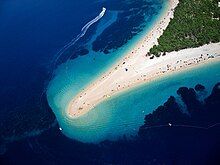
Privatization and the drive toward a market economy had barely begun under the new Croatian Government when war broke out in 1991. As a result of the war, the economic infrastructure sustained massive damage, particularly the revenue-rich tourism industry. From 1989 to 1993, GDP fell 40.5%. With the end of the war in 1995, tourism and Croatia's economy recovered moderately. However, corruption, cronyism, and a general lack of transparency stymied meaningful economic reform, as well as much-needed foreign investment.
Croatia's economy turned the corner in 2000 as tourism rebounded. The economy expanded in 2002, stimulated by a credit boom led by newly privatized and foreign-capitalized banks, some capital investment, most importantly road construction, further growth in tourism, and gains by small and medium-sized private enterprises.
Croatia has a high-income market economy. International Monetary Fund data shows that Croatian nominal GDP stood at $69.357 billion, or $15,633 per capita, at the same time in 2008 purchasing power parity GDP was $82.407 billion or $18,575 per capita.
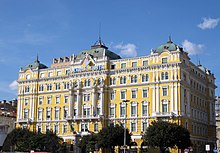

According to Eurostat data, Croatian PPS GDP per capita stood at 63.2 percent of the EU average in 2008. Real GDP growth in 2007 was 6.0 per cent. and at the same time average gross salary of a Croatian worker during the first nine months of 2008 was 7,161 kuna (US$ 1,530) per month In 2007, the International Labour Organization-defined unemployment rate stood at 9.1 per cent, after falling steadily from 14.7 percent in 2002. The registered unemployment rate is higher, though, standing at 13.7 percent in December 2008.
In 2009, economic output was dominated by the service sector which accounted for 73,6% percent of GDP, followed by the industrial sector with 20,5% and agriculture accounting for 5,9% of GDP. According to 2004 data, 2.7 percent of the workforce were employed in agriculture, 32.8 percent by industry and 64.5 in services.
The industrial sector is dominated by shipbuilding, food processing, pharmaceuticals, information technology, biochemical and timber industry. Tourism is a notable source of income during the summers, with over 11 million foreign tourists in 2008 generating a revenue of €8 billion. Croatia is ranked as the 18th most popular tourist destination in the world. In 2008 Croatia exported goods to the value of $14.4 billion (FOB) ($26.4 billion including service exports).
The Croatian state still controls a significant part of the economy, with government expenditure accounting for as much as 40% of GDP. Some large, state-owned industries, such as the country's shipyards, continue to rely on government subsidies but with EU membership looming, Croatia is forced to restructure debt ridden shipyards as it is a prerequisites for Croatia before it joins the EU. Subsidies for loss making industries also reduce needed investments in to education and technology needed to ensure the economy's long-term competitiveness.
Of particular concern is the backlogged judiciary system, combined with inefficient public administration, especially issues of land ownership and corruption. Another main problem includes the large and growing national debt which has reached over 34 billion euro or 89.1 per cent of the nations gross domestic product. Because of these problems, studies show that the population of Croatia generally has negative expectations of the country's economic future.
Croatia has so far weathered the global financial crisis reasonably well, but faces significant challenges in 2010 largely due to Croatia's external imbalances and high foreign debt, which in longer term presents problems for Croatian financial sector due to higher cost of borrowing to cover current account deficit.
The country has been preparing for membership in the European Union, its most important trading partner. In February 2005, the Stabilisation and Association Agreement with the EU officially came into force and by the end of 2009 Croatia has closed 17 EU accessions chapters, with remaining 16 to be completed by the end of first half of 2010. Croatia is expected to join the EU sometimes in 2011 or January first 2012 together with Iceland.
Transport
Main article: Transport in Croatia
The highlight of Croatia's recent infrastructure developments is its rapidly growing motorway network, of which plans were drawn and work commenced in the 1970s, but was realised only after independence because of the (then) Yugoslav Government plans of road projects of 'national' importance. In 1997, at the Third Ministerial Session of the European Conference of Ministers of Transport, routes of four Pan-European corridors were defined running through Croatia, giving extra importance to Croatian road network.
Croatia has now over 1,100 kilometres (680 miles) of completed motorways connecting Zagreb to most other regions. The best known and the busiest motorways are the A1, connecting Zagreb to Split and the A3, passing east–west through northwest Croatia and Slavonia. Toll is charged at most sections of the motorways—the most notable exceptions are Zagreb bypass and Rijeka bypass. There is also a smaller and less known network of expressways connecting to the motorways. The most heavily used ones are the B8, connecting the A7 near Rijeka to the A9 north of Pula, and the D28 spanning from the A4 near Zagreb to Bjelovar. The Croatian motorway network is of very good overall quality and excellent safety, confirmed by several EuroTAP and EuroTest awards.

Croatia has an extensive rail network, although due to historical circumstances, some regions (notably Istria and even more so Dubrovnik) are not accessible by train without passing through neighboring countries. Serious investment is needed in the rail network over the coming decades to bring it up to European standards in both speed and operational efficiency. All rail services are operated by Croatian Railways (Template:Lang-hr). The inter-city bus network (operated by private operators) is extensively developed, with higher levels of coverage and timetables than the railways.
Croatia has three major international airports, located in Zagreb, Split and Dubrovnik. Other important airports include Zadar, Rijeka (on the island of Krk), Osijek, Bol, Lošinj and Pula. Croatia Airlines is the national airline and flag carrier. The U.S. Federal Aviation Administration (FAA) has assessed the Government of Croatia’s Civil Aviation Authority as being in compliance with International Civil Aviation Organization (ICAO) aviation safety standards for oversight of Croatia’s air carrier operations.
An extensive system of ferries, operated by Jadrolinija, serves Croatia's many islands and links coastal cities. Ferry services to Italian cities of Venice, Ancona, Pescara and Bari from around a dozen of Croatian sea ports, most notably Rovinj, Rijeka, Zadar, Split, Korčula and Dubrovnik, is available on a daily or weekly basis. From April to September the schedule is more dense and can include several round trips within a day.
Demographics


| Religion in Croatia | ||||
|---|---|---|---|---|
| religion | percent | |||
| Roman Catholicism | 87.8% | |||
| Atheism or Agnosticism | 5.2% | |||
| Eastern Orthodoxy | 4.4% | |||
| Islam | 1.3% | |||
| Other or None | 0.9% | |||
| Protestantism | 0.3% | |||
Croatia's 2001 census recorded a total population of 4,437,460. This is estimated to have risen to 4,489,409 by 2009.
Croatia is inhabited mostly by Croats (89.6%), while minority groups include Serbs (4.5%), Bosniaks, Hungarians, Italians, Slovenes, Germans, Czechs, Romani people and others (5.9%). For most of the 20th century, the population of Croatia has been rising from 3,430,270 in 1931 to 4,784,265 in 1991. The natural growth rate of the population is currently negative with the demographic transition completed in the 1970s.
Average life expectancy is 75.1 years, and the literacy rate is 98.1 percent. During recent years, the Croatian government is pressured each year to add 40% to work permit quotas for foreign workers and in accordance with its immigration policy it is trying to entice emigrants to return. The main religions of Croatia are Roman Catholic 88%, Orthodox 4.4%, other Christian 0.4%, Muslim 1.3%, other and unspecified 0.9%, none 5.2%.
During the last decade of the 20th century the population of Croatia has been stagnating because of the Croatian War of Independence. During the war, large sections of the population were displaced and emigration increased. In 1991, in predominantly Serb areas, more than 400 000 Croats and other non-Serbs were either removed out of their homes by the Croatian Serb forces or fled the violence. During the final days of the war in 1995, more than 120,000 Serbs, and perhaps as many as 200,000 fled before the victory by Croatian forces.
Only a small fraction of Serbs have returned to their homes since 1995, according to Human Rights Watch. Most of Croatia's remaining Serbs do not live in the highlands and inland of Dalmatia but rather in the Croatian heartland and major cities. Serbs have been only partially re-settled by the Croatian Government in the regions they previously inhabited (i.e., the blue areas of the map here). Many of the towns previously settled by Serbs were settled by Croat refugees from Bosnia and Herzegovina, mostly from Republika Srpska.
Education
Main article: Education in Croatia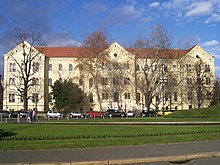
Primary education in Croatia starts at the age of six or seven and consists of eight grades. In 2007 a law was passed to increase free but not compulsory education until eighteen years of age. Compulsory education consists of eight grades (Elementary School) Secondary education is provided by gymnasiums and vocational schools.

Croatia has eight universities, the University of Zagreb, University of Split, University of Rijeka, University of Osijek, University of Zadar, University of Dubrovnik the University of Pula and Dubrovnik International University. The University of Zadar, the first University in Croatia, was founded in 1396 and remained active until 1807, when other institutions of higher education took over until the foundation of the renewed University of Zadar in 2002. The University of Zagreb, founded in 1669, is the oldest continuously operating University in Southeastern Europe. There are also 11 polytechnics and 23 higher education institutions of which 19 are private.
There are numerous public music schools on the primary and secondary education levels. Over thirty scientific institutes are registered in Croatia, the largest one being the Institute "Ruđer Bošković" in Zagreb that excels in physics. The Croatian Academy of Sciences and Arts in Zagreb is a learned society promoting language, culture, arts and science from its first conception in 1836.
According to a survey ordered by the European commission in 2005, 49% of Croats speak English, 34% speak German, 14% Italian, 4% French and Russian and 2% Spanish language.
A worldwide study about the quality of education in different countries published by Newsweek in August 2010 ranked Croatian education system on the 22nd place, to share the position with Austria.
Culture
Main article: Culture of Croatia See also: Art of Croatia, Architecture of Croatia, Croatian literature, Croatian cuisine, and Music of Croatia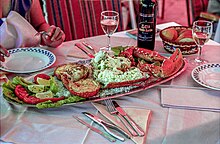

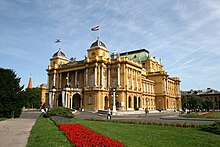
| This section needs additional citations for verification. Please help improve this article by adding citations to reliable sources in this section. Unsourced material may be challenged and removed. (January 2011) (Learn how and when to remove this message) |
Croatian culture is the result of a fourteen century-long history which has seen the development of many cities and monuments and also includes many adoptions from ancient Greek, Roman and Illyrian cultures. The culture of Croatia can be divided into two cultural circles: Central European and Mediterranean. The country includes seven World Heritage sites and eight national parks. Croatia is also the birthplace of a number of historical figures. Included among the notable people are three Nobel prize winners and numerous inventors. The country is also rich with Intangible culture and holds the largest number of UNESCO's World's intangible culture masterpieces in Europe.
Regional cultures are considered variations on the larger category of "Croatian", including the cultures of Dalmatia, Istria, Slavonia, and Zagorje. These regions are characterized by differences in geography, traditional economy, food, folkloric tradition, and dialect. Despite that, Croats share an overall sense of national culture but at the same time often feel strong about regional identities and about local cultural variations. Cultural variations, particularly regional cuisine, are related to geographic variations within the country. Traditional economies are also linked to geography. The capital, Zagreb, is centrally located but was not chosen for that reason. It is the largest city, but also historically the political, commercial, and intellectual center.
Some of the world's first fountain pens came from Croatia. Croatia also has a place in the history of clothing as the origin of the necktie (kravata). The country has a long artistic, literary and musical tradition. Also of interest is the diverse nature of Croatian cuisine and the famous Croatian Traditional gift Licitar.
Croatians are protective of the their Croatian language from foreign influences as the language was under constant change and threats imposed by previous rulers (i.e. Austrian German, Hungarian, Italian and Turkish words were changed and altered to "Slavic" looking/sounding ones).
The Croatian language has three major dialects, identified by three different words for "what" ća, kaj and što. From 1961 to 1991, the official language was Serbo-Croatian. Even under socialism, Croats often referred to their language as Croato-Serbian (instead of Serbo-Croatian) or as Croatian. Croatian and Serbian variants of the language were never recognized as different, but referred as the west and east version, and had different alphabets; Latin alphabet and Serbian Cyrillic.
In the late 19th and 20th century, Serbian and Yugoslav nationalist scholars began to impose policies to change or alter Croatian words into "Serbian" or "South Slavic" ones, which have infuriated Croats over the purity and preservation of their native language (See Croatian linguistic purism). Under the Habsburgs, Latin was the official language of the Croatian government and Sabor. At the same time, besides Croatian, many Croats used German and Italian in everyday life. A national reawakening in the 19th century focused on the establishment of a national language as the official one.
During socialist Yugoslavia, a Yugoslav identity was promoted and symbols and expressions of national identity were suppressed and punishable by jail terms. The Croatian Spring, the most notable and only large-scale nationalist movement during Tito's regime, was put down in 1971 with most of its leadership imprisoned. It was led by important Croatian communists and was based on economic disagreement with the Serb elite in Belgrade.

The newly independent state has had to recreate a national culture by drawing from history and folk culture. The modern national identity draws on its medieval roots, association with Viennese "high culture," culturally diverse rural traditions, and Roman Catholicism.
A cravat (in modern English renamed to Necktie), symbol of culture and elegance, originates from the 17th century Croatia where it was part of the uniform worn by Croatian soldiers. It was disseminated across Europe during Thirty Years' War (1618–1648) by Croatian regiments serving under Austria. From 1635 Croatian soldiers also served in France and in 1667 a special regiment named Royal Cravates was formed. Common soldiers wore scarves made of coarse materials and officers wore scarves made of fine cotton or silk. French King Louis XIV fell in love with the Croatian attire and soon replaced the starched high-lace collar the French used to wear with the cravat, much more practical and beautiful piece of clothing. When the most powerful European king put on the cravat, a new fashion was born. Later on, cravat was accepted in all corners of the world as a standard and still carries the Croatian name in its name in majority of modern languages.
Architecture
Main article: World Heritage Sites in CroatiaArchitecture in Croatia reflects the influence of the bordering nations. Austrian and Hungarian influences are visible in public space and buildings in the north and central regions. Large squares named for culture heroes, well-groomed parks, and pedestrian-only zones, are features of these orderly towns and cities. Muted colors prevail, especially tones of yellow and gold. In urban areas, houses are built right up to the street. An inner courtyard sometimes provides space for a small garden. Modern houses in cities and villages usually have two or three stories with masonry and stucco.
Along the coast, the architecture is Mediterranean. Houses are usually made of stucco and painted white, and have red tile roofs. Cities and towns still have the characteristic open markets, squares, and Catholic churches, but are less likely to be laid out in a neat grid. Generally speaking, continental architecture is of baroque architecture gauge and coastal areas are examples of renaissance architecture.

World heritage sites in Croatia include:
- Historical Complex of Split with the Palace of Diocletian (1979)
- Old City of Dubrovnik (1979)
- Plitvice Lakes National Park (1979)
- Episcopal Complex of the Euphrasian Basilica in the Historic Centre of Poreč (1997)
- Historic City of Trogir (1997)
- The Cathedral of St. James in Šibenik (2000)
- The Stari Grad Plain – island of Hvar (2008)
Sport
Main article: Sport in Croatia| This section does not cite any sources. Please help improve this section by adding citations to reliable sources. Unsourced material may be challenged and removed. (January 2011) (Learn how and when to remove this message) |
The most popular sports in Croatia are football, handball, basketball, water polo, tennis, and skiing.
The Croatian national football team won a bronze medal in the 1998 FIFA World Cup and Davor Šuker won the Golden Boot as the top goal scorer. The national football team has also played in the quarter-finals of the 1996 European Championships and the 2008 European Championships. The team is currently ranked 9th in the FIFA World Rankings (as of January 2011). The most popular football players are Luka Modrić, Darijo Srna, Ivica Olić, Niko Kranjcar.



The Croatia national handball team is a two-time Olympic Champion (1996 and 2004). The team also won a gold medal at the 2003 World Men's Handball Championship, and silver medals in the 1995, 2003 and 2009 World Championships. Croatia won bronze medal in 1994 European Championships and silver in 2008. RK Zagreb was a 1992 and 1993 European champion and 4 times a runner-up (1995, 1997, 1998 and 1999). Croatian players Ivano Balić, Igor Vori and Domagoj Duvnjak are currently among the best handball players in the world.
The Croatian national basketball team won a silver medal at the 1992 Olympic basketball tournament, bronze medal at the 1994 FIBA World Championship and bronze medals at EuroBasket 1993 and EuroBasket 1995. Croatian basketball clubs were Euroleague champions 5 times: KK Split three times (in 1989, 1990 and 1991) and KK Cibona in 1985 and 1986. Croatian basketball players such as Dražen Petrović, Krešimir Ćosić and Toni Kukoč were amongst the first foreign players to succeed in the NBA in the United States.
The Croatia national water polo team won a gold medal at the 2007 FINA World Championships and bronze medal in 2009. The team also won a silver medal at the 1996 Olympic water polo tournament and gold medal at the 2010 European Championship as well as silver medals in the 1999 and 2003 European Championships. Croatian water polo clubs were 13 times LEN Euroleague champions. HAVK Mladost from Zagreb was a seven time European Champion (in 1968, 1969, 1970, 1972, 1990, 1991 and 1996) and was awarded the title Best Club of the 20th Century by the LEN. VK Jug from Dubrovnik and VK Jadran from Split were both three time European champions.
The Croatian Davis Cup team (Ivan Ljubičić, Mario Ančić and Ivo Karlović with coach Nikola Pilić) won the 2005 Davis Cup tournament and reached semifinals in 2009 tournament (Marin Čilić and Ivo Karlović with coach Goran Prpić). Goran Ivanišević is one of the country's most popular sportsmen. Ivanišević won the 2001 Wimbledon Men's singles title and reached number 2 spot in ATP Rankings in July 1994. Ivan Ljubičić reached number 3 spot in ATP Rankings in May 2006. Iva Majoli won the 1997 Roland Garros Women's Singles title. Currently the best Croatian tennis player is Marin Čilić ranked 14th as of November 16, 2009.
Janica Kostelić is the most successful female alpine ski racer in the history of the Winter Olympic Games. She is the only woman to win four gold medals in alpine skiing at the Winter Olympics Alpine skiing events (in 2002 and 2006), and the only woman to win three alpine skiing gold medals in one Olympics (2002). She also won two slilver medals in 2006. Janica was the World Cup overall champion in 2001, 2003, and 2006. On February 5, 2006 Janica became only the second female skier to win all five disciplines in one season. She also holds the record for the highest number of points in one World Cup season. In 2006 she won Laureus World Sports Award for Sportswoman of the Year. Her elder brother Ivica Kostelić was the 2003 World Champion in slalom and is a three-time Winter Olympic silver medalist himself.
Blanka Vlašić is the best-known Croatian track and field athlete; she specialises in the high jump. She is 2007 and 2009 World Champion. Blanka is also 2008 World Indoor Champion and 2008 Olympic silver medalist. Her personal best is 2.08 m (6 ft 9.89 in) (which is only 1 cm less than the world record) set in Zagreb at August 31, 2009.
Biathlete Jakov Fak won bronze medal in World Championships 2009 in Pyeongchang and another bronze medal in 2010 Winter Olympics in Vancouver. Before Fak Croatia had no success or tradition in biathlon.
Croatia women's national volleyball team won silver medals three times at European Volleyball Championship in 1995, 1997 and 1999.
Other well-known Croatian athletes are Duje Draganja, Gordan Kožulj, Sanja Jovanović and Đurđica Bjedov in swimming, Zoran Primorac, Dragutin Šurbek, Antun Stipančić and Tamara Boroš in table tennis, Filip Ude in gymnastics, Siniša and Nikša Skelin in rowing, Martina Zubčić and Sandra Šarić in taekwondo, Snježana Pejčić in shooting, Matija Ljubek in canoeing, Željko Mavrović and Mate Parlov in boxing, and Branko Cikatić and Mirko "Cro Cop" Filipović in kickboxing.
See also
Main article: Outline of Croatia- Public holidays in Croatia
- Military of Croatia
- Protected areas of Croatia
- Telecommunications in Croatia
- Timeline of Croatian history
- Tourism in Croatia
Lists:
References
- ^ "Croatia". The World Factbook. CIA. Retrieved 2009-10-13. Cite error: The named reference "cia" was defined multiple times with different content (see the help page).
- ^ Frucht 2005, p. 415
- ^ "Croatia". International Monetary Fund. Retrieved 2010-10-06.
- "Distribution of family income – Gini index". The World Factbook. CIA. Retrieved 2009-09-01.
- "Human Development Report 2010" (PDF). United Nations. 2010. Retrieved 5 November 2010.
- "Subdivision of Europe" (PDF). United Nations.
- "map of European regions according to the UN (cultural and political criteria) (In German)". Permanent committee on geographical names.
- ^ "Identity Card / Information". Government of the Republic of Croatia. Retrieved 2010-04-26.
- Wilkes, J. J. (1992). The Illyrians. Oxford, UK: Blackwell. p. 114. ISBN 0631198075.
... in the early history of the colony settled in 385 BC on the island Pharos (Hvar) from the Aegean island Paros, famed for its marble. In traditional fashion they accepted the guidance of an oracle, ...
- Gibbon, Edward. The Decline and Fall of the Roman Empire, Modern Library, New York, p. 335
- "J. B. Bury, ''History of the Later Roman Empire'', §4, p. 408". Penelope.uchicago.edu. Retrieved 2010-05-16.
- De Administrando Imperio, Byzantine Emperor Constantine VII Porphyrogenitos,
- De Administrando Imperio, Byzantine Emperor Constantine VII Porphyrogenitos, chap. 31
- Stjepan Antoljak, Pregled hrvatske povijesti, Split 1993., str. 43.
- Opća enciklopedija JLZ. Zagreb. 1982.
{{cite book}}:|work=ignored (help)CS1 maint: location missing publisher (link) - Recipiebant enim regie dignitatis insignia ab imperatoribus Constantinopolitanis et dicebantur eorum eparchi siue patritii
- Ivan Stagličić. "Kako je Ladislav prodao Dalmaciju". Zadarskilist.hr. Retrieved 2010-05-16.
- "Michigan state university libraries-Steven W. Sowards:25 lectures on modern Balkan history". Staff.lib.msu.edu. 2009-06-11. Retrieved 2010-05-16.
- ^ "History of Croatian parliament on Croatian". Sabor.hr. Retrieved 2010-05-16.
- Milan Kruhek: Cetin, grad izbornog sabora Kraljevine Hrvatske 1527, Karlovačka Županija, 1997, Karlovac
- Andrew Archibald Paton (1861). Researches on the Danube and the Adriatic; Or Contributions to the Modern History of Hungary and Translvania, Dalmatia and Croatia, Servia and Bulgaria, Brockhaus
- Shelton, Edward (1867). The book of battles: or, Daring deeds by land and sea. London: Houlston and Wright. pp. 82–83.
- "Timothy Hughes Rare & Early Newspapers, Item 548456". Rarenewspapers.com. Retrieved 2010-05-16.
- Ivan Stagličić. "Zadarski list – Naslovnica". Zadarskilist.hr. Retrieved 2010-05-16.
- Jean Nouzille: Histoire de frontieres: L'Autriche et l'Empire Ottoman, page 263
- "Constitution of Union between Croatia-Slavonia and Hungary". H-net.org. Retrieved 2010-05-16.
- "Govor Ivana Kukuljevića Sakcinskog u Saboru 2 svibnja 1843". Sabor.hr. Retrieved 2010-05-16.
- Montani, Carlo. Venezia Giulia, Dalmazia – Sommario Storico – An Historical Outline
- "Povijest saborovanja". Sabor.hr. Retrieved 2010-05-16.
- Naputak Narodnog vijeća SHS delegaciji za pregovore i utanačenje ujedinjenja države SHS s Kraljevinom Srbijom
- ^ Spencer Tucker. Encyclopedia of World War I: A Political, Social, and Military History. Santa Barbara, California, USA: ABC-CLIO, 2005. Pp. 1189.
- Einstein accuses Yugoslavian rulers in savant's murder, New York Times. May 6, 1931. mirror
- "Independent State of Croatia – Britannica Online Encyclopedia". Britannica.com. Retrieved 2010-05-16.
- Yugoslavia, Holocaust Encyclopedia, United States Holocaust Memorial Museum
- "Independent State of Croatia laws on Croatian" (PDF). Retrieved 2010-05-16.
- Encyclopædia Britannica. "Ustaša – Britannica Online Encyclopedia". Britannica.com. Retrieved 2010-05-16.
- Jasenovac, Holocaust Encyclopedia, United States Holocaust Memorial Museum
- John R. Lampe (ed.), Mark Mazower (ed.). Ideologies and national identities: the case of twentieth-century southeastern Europe. Budapest, Hungary: Central European University Press, 2004. Pp. 68.
- ^ Bernd Jürgen Fischer (ed.). Balkan strongmen: dictators and authoritarian rulers of South Eastern Europe. Purdue University Press, 2007. Pp. 214.
- Jasenovac Jewish Virtual Library. Accessed 2008-08-10. "The most reliable figures place the number of Serbs killed by the Ustaša between 330,000 and 390,000, with 45,000 to 52,000 Serbs murdered in Jasenovac."
- Election Opens Old Wounds In Trieste. The New York Times. June 6, 1987.
- A recent study by Vladimir Žerjavić estimates total war related deaths at 1,027,000. Bogoljub Kočović calculated that the actual war losses were 1,014,000.
- "Croatian constitution". Sabor.hr. Retrieved 2010-05-16.
- "Kosovo: One year after the riots". Osa.ceu.hu. Retrieved 2010-05-16.
- Frucht 2005, p. 433
- "Leaders of a Republic In Yugoslavia Resign". The New York Times. Reuters. January 12, 1989. Retrieved February 7, 2010.
- "DEKLARACIJA o proglašenju suverene i samostalne Republike Hrvatske". Narodne Novine (in Croatian). Narodne Novine d.d. June 25, 1991. Retrieved December 12, 2010.
{{cite news}}: Unknown parameter|trans_title=ignored (|trans-title=suggested) (help) - Chuck Sudetic (June 26, 1991). "2 YUGOSLAV STATES VOTE INDEPENDENCE TO PRESS DEMANDS". The New York Times. Retrieved December 12, 2010.
- "Ceremonial session of the Croatian Parliament on the occasion of the Day of Independence of the Republic of Croatia (Zagreb, October 7, 2004)". Official web site of the Parliament of Croatia. Parliament of Croatia. October 7, 2004. Retrieved December 16, 2010.
- Chuck Sudetic (November 4, 1991). "Army Rushes to Take a Croatian Town". The New York Times. Retrieved December 16, 2010.
- ^ "Croatia Clashes Rise; Mediators Pessimistic". The New York Times. December 19, 1991. Retrieved December 16, 2010.
- "History and ethnic relations". Everyculture.com. Retrieved 2010-11-14.
- Dusan Bilandzic: Hrvatska moderna povijest
- Chuck Sudetic (October 2, 1990). "Croatia's Serbs Declare Their Autonomy". The New York Times. Retrieved December 11, 2010.
- Eastern Europe and the Commonwealth of Independent States. Routledge. 1998. pp. 272–278. ISBN 1-85743-058-1. Retrieved December 16, 2010.
- "ICTY Sentencing Judgement". Un.org. 2007-03-05. Archived from the original on March 10, 2007. Retrieved 2010-05-16.
- Dean E. Murphy (August 8, 1995). "Croats Declare Victory, End Blitz". Los Angeles Times. Retrieved December 18, 2010.
- "United Nations". Un.org. 2007-03-05. Archived from the original on March 17, 2008. Retrieved 2010-05-16.
- Stephen Kinzer (December 24, 1991). "Slovenia and Croatia Get Bonn's Nod". The New York Times. Retrieved December 16, 2010.
- Paul L. Montgomery (May 23, 1992). "3 Ex-Yugoslav Republics Are Accepted Into U.N." The New York Times. Retrieved December 12, 2010.
- "Važniji datumi iz povijesti saborovanja". Hrvatski Sabor. Retrieved 2008-04-23.
- "Dinara – Climbing, Hiking & Mountaineering". SummitPost. Retrieved 2008-05-16.
- "BIB.irb.hr" (PDF). Retrieved 2010-11-14.
- "What is karst?". Underground Istria. Retrieved 2010-05-16.
- "Caves in Croatia". The Speleological Committee of the Croatian Mountaineering Association. Retrieved 2008-08-22.
- ^ OSCE Mission to Croatia retrieved May 19, 2007
- Police, Croatia retrieved May 19, 2007
- Modernisierung durch Transfer im 19. und frühen 20. Jahrhundert Von Tomasz Giaro. Vittorio Klostermann. 2006. ISBN 9783465034896.
- ^ "Background Note: Croatia". U.S. Department of state. Retrieved 2008-12-04.
- "World Bank Country Classifications 2008". Web.worldbank.org. Retrieved 2010-05-16.
- "GDP per capita in PPS" (PDF). Eurostat. Retrieved 2009-06-25.
- "Real GDP growth rate". Eurostat. Retrieved 2008-05-21.
- "Plaće nominalno veće, ali realno u padu". Suvremena.hr (in Croatian). 2008-11-06. Retrieved 2008-11-21.
- "Unemployment rate – total". Eurostat. Retrieved 2008-03-09.
- "Bulletin 134" (PDF). Croatian National Bank. February 2008. Retrieved 2008-03-22.
- "Croatian Chamber of Economy Brochure for year 2009" (PDF).
- "World Economic Outlook Database". International
Monetary Fund. October 2007. Retrieved 2008-03-09.
{{cite web}}: line feed character in|publisher=at position 14 (help) - ^ "UNWTO World Tourism Barometer" (PDF). October 2007. Retrieved 2008-04-23.
- "Analysis: Despite debt, Croatia "not under financial collapse threat"". Monstersandcritics.com. 2008-06-18. Retrieved 2010-05-16.
- "Gallup Balkan monitor:2008 Summary of findings" (PDF). Retrieved 2010-05-16.
- "Iceland 'could join EU by 2011'". BBC News. 2009-01-30. Retrieved 2010-11-14.
- Jakša Miličić (2004). "Autocesta Split - Zagreb". Hrvatska revija (in Croatian). Matica hrvatska. Retrieved May 16, 2010.
{{cite web}}: Unknown parameter|trans_title=ignored (|trans-title=suggested) (help) - Tihomir Ponoš (June 27, 2004). "Naša ideja je bila izgraditi ono što samo zvali 'hrvatski križ'" (PDF). Vjesnik (in Croatian). Retrieved October 7, 2010.
{{cite news}}: Unknown parameter|trans_title=ignored (|trans-title=suggested) (help) - Tanja Poletan Jugović (April 11, 2006). "The integration of the Republic of Croatia into the Pan-European transport corridor network". Pomorstvo. 20 (1). University of Rijeka, Faculty of Maritime Studies: 49–65. Retrieved October 14, 2010.
- "Odluka o razvrstavanju javnih cesta u autoceste". Narodne Novine (in Croatian). July 25, 2007. Retrieved October 18, 2010.
{{cite news}}: Unknown parameter|trans_title=ignored (|trans-title=suggested) (help) - "Odluka o izmjenama i dopunama odluke o razvrstavanju javnih cesta u autoceste". Narodne Novine (in Croatian). January 30, 2009. Retrieved October 18, 2010.
{{cite news}}: Unknown parameter|trans_title=ignored (|trans-title=suggested) (help) - "Traffic counting on the roadways of Croatia in 2009 - digest" (PDF). Hrvatske ceste. Retrieved May 1, 2010.
- "EuroTest". Eurotestmobility.com. Retrieved 2009-01-03.
- "Brinje Tunnel Best European Tunnel – Croatia – Javno". Javno.com. Retrieved 2009-01-03.
- "U.S. Department of State". Travel.state.gov. Retrieved 2010-05-16.
- "Vojska.net". Vojska.net. Retrieved 2010-05-16.
- Mrđen, Snježana (1998). "The demographic situation in Croatia". Geoadria. 3: 29–56.
- "Traži se 40% više kvota za strane radnike". poslovni.hr. Retrieved 2010-05-16.
- "CEEOL Political Thought: Croatian Political Science Review , Issue 05 /1998". Ceeol.com. Retrieved 2010-05-16.
- "Summary of judgement for Milan Martić". United Nations. 2007-06-12. Archived from the original on December 15, 2007. Retrieved 2008-06-21.
- Erlanger, Steven (2000-01-16). "For Serbs in Croatia, a Pledge Unkept". nytimes.com. Retrieved 2000-01-16.
{{cite news}}: Check date values in:|accessdate=(help) - Prodger, Matt (2005-08-05). "Bbc News". BBC News. Retrieved 2010-05-16.
- "refugee-rights@hrea.org – Croatia: Plight of returning Serb refugees may slow EU bid". Hrea.org. Retrieved 2009-01-03.
- "Europeans and their languages – European commission special barometer FEB2006" (PDF). Retrieved 2010-01-05.
- "Newsweek study of Health, Education, Economy and Politics ranks the globe's top nations". Newsweek.com. 2010-08-15. Retrieved 2010-11-14.
- "Academia Cravatica". Academia-cravatica.hr. Retrieved 2010-11-14.
- "International Handball Federation". Ihf.info. Retrieved 2010-11-14.
- "European athletics association". European-athletics.org. Retrieved 2010-11-14.
- Bibliography
- Cresswell, Peterjon; Atkins, Ismay; Dunn, Lily (10 July 2006). Time Out Croatia (First ed.). London, Berkeley & Toronto: Time Out Group Ltd & Ebury Publishing, Random House Ltd. 20 Vauxhall Bridge Road, London SV1V 2SA. ISBN 9781904978701. Retrieved 10 March 2010.
- Agičić et al., Povijest i zemljopis Hrvatske, priručnik za hrvatske manjinske škole (History and Geography of Croatia, a handbook for Croatian minority schools), Biblioteka Geographica Croatica, 292 pages, Zagreb:2000 (ISBN 953-6235-40-4) Template:Hr icon
- Branka Magaš. "Croatia Through History: The Making of a Modern European State" Saqi. November 2007, 680pp.
- Ivo Banac, The National Question in Yugoslavia: Origins, History, Politics Cornell University Press, 1984.
- Mirjana Kasapović (ed.), Hrvatska politika 1990.-2000. Zagreb: Hrvatska politologija 2001.
- Pavol Demes and Jörg Forbrig (eds.), Reclaiming Democracy: Civil Society and Electoral Change in Central and Eastern Europe. German Marshall Fund, 2007. ISBN 978-80-969639-0-4
- Sharon Fisher, Political Change in Post-Communist Slovakia and Croatia: From Nationalist to Europeanist. New York: Palgrave Macmillan, 2006 ISBN 1403972869
- Frucht, Richard C. (2005). Eastern Europe: An Introduction to the People, Lands, and Culture. ABC-CLIO. ISBN 1576078000, 9781576078006.
{{cite book}}: Check|isbn=value: invalid character (help)
External links
- Official website
- "Croatia". The World Factbook (2025 ed.). Central Intelligence Agency.
- Template:Dmoz
 Wikimedia Atlas of Croatia
Wikimedia Atlas of Croatia- Template:Wikitravel
| Geographic locale | |||||||||||||||||||||||||||||||||||||||||||||||||||
|---|---|---|---|---|---|---|---|---|---|---|---|---|---|---|---|---|---|---|---|---|---|---|---|---|---|---|---|---|---|---|---|---|---|---|---|---|---|---|---|---|---|---|---|---|---|---|---|---|---|---|---|
| |||||||||||||||||||||||||||||||||||||||||||||||||||
| Within Croatia | ||||||||||||||||||||||||||||||||||||
|---|---|---|---|---|---|---|---|---|---|---|---|---|---|---|---|---|---|---|---|---|---|---|---|---|---|---|---|---|---|---|---|---|---|---|---|---|
| ||||||||||||||||||||||||||||||||||||
| International membership and history | |||||||||||||||||||||||||||||||||||||||||||||||||||||||||||||||||||||||||||||||||||||||||||||||||||||||
|---|---|---|---|---|---|---|---|---|---|---|---|---|---|---|---|---|---|---|---|---|---|---|---|---|---|---|---|---|---|---|---|---|---|---|---|---|---|---|---|---|---|---|---|---|---|---|---|---|---|---|---|---|---|---|---|---|---|---|---|---|---|---|---|---|---|---|---|---|---|---|---|---|---|---|---|---|---|---|---|---|---|---|---|---|---|---|---|---|---|---|---|---|---|---|---|---|---|---|---|---|---|---|---|
Template:Slavic-speaking states
| |||||||||||||||||||||||||||||||||||||||||||||||||||||||||||||||||||||||||||||||||||||||||||||||||||||||
- Ill-formatted IPAc-en transclusions
- Articles with empty sections from September 2010
- Croatia
- Countries of the Mediterranean Sea
- European countries
- Liberal democracies
- Member states of the Union for the Mediterranean
- Members of the North Atlantic Treaty Organization
- Republics
- Serbo-Croatian-speaking countries
- Slavic countries
- States and territories established in 1991


